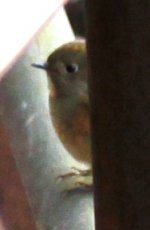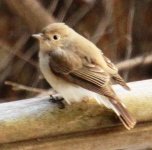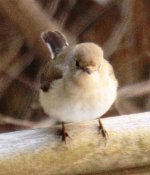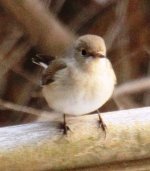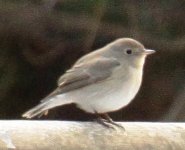I took these pictures one afternoon at a hill park in central Seoul on December 11, 2013. The closest match I could find in the Field Guide to the Birds of Korea was the Red-breasted Flycatcher (ficedula parva). But it's listed as a rare passage migrant in the book, which led me to question my ID. Does anybody have any ideas? Thanks.
-
Welcome to BirdForum, the internet's largest birding community with thousands of members from all over the world. The forums are dedicated to wild birds, birding, binoculars and equipment and all that goes with it.
Please register for an account to take part in the discussions in the forum, post your pictures in the gallery and more.
You are using an out of date browser. It may not display this or other websites correctly.
You should upgrade or use an alternative browser.
You should upgrade or use an alternative browser.
Red-breasted Flycatchers? Seoul (1 Viewer)
- Thread starter jimthom
- Start date
More options
Who Replied?I believe there has been a 'split' and the bird in east Asia is now the Taiga Flycatcher, Ficedula albicella. The tail pattern with white edges which stop before the end is distinctive, I think. A few overwinter in Japan; I once saw one in northern Kyushu in January.
It may still be on its way south - there will always be some stragglers. Or maybe a few over-winter there also (though I think Seoul will be much colder than lowland Kyushu).
But someone who knows better than me will probably be along soon.
It may still be on its way south - there will always be some stragglers. Or maybe a few over-winter there also (though I think Seoul will be much colder than lowland Kyushu).
But someone who knows better than me will probably be along soon.
Simon Wates
Well-known member
The 2nd photo shows brown on the upper tail coverts and a rather pale bill, which would indicate Red-breasted rather than Taiga (I think).
JWN Andrewes
Poor Judge of Pasta.
That first one seems to have a much finer bill, a neat whitish throat patch and some orange tones around the flanks; it's not a Red-flanked Bluetail is it? (Just to be clear, if I'm completely wrong I will be blaming the monitor!)
James
James
That first one seems to have a much finer bill, a neat whitish throat patch and some orange tones around the flanks; it's not a Red-flanked Bluetail is it? (Just to be clear, if I'm completely wrong I will be blaming the monitor!)
James
Yes, I think you are right. I noticed this, but blamed photo artefacts, assuming the OP had posted photos of one bird. But on looking closely, it's definitely different.
The 2nd photo shows brown on the upper tail coverts and a rather pale bill, which would indicate Red-breasted rather than Taiga (I think).
Well, Red-breasted would be 'accidental' in Korea, rather than a late migrant, so in this case the OP would have got something very special. My knowledge and eye aren't good enough to say.
Simon Wates
Well-known member
Well, Red-breasted would be 'accidental' in Korea, rather than a late migrant, so in this case the OP would have got something very special. My knowledge and eye aren't good enough to say.
I had no idea - in that case take my opinion with a pinch of salt! I don't know what other options there are in Korea - I'm sure someone will answer who does.
chris butterworth
aka The Person Named Above
#1 is a Red-flanked Bluetail, by the shape and 'weight'of the bill and the clearly marked whitish throat. Female and 1st winter Red-breasted and Taiga Flycatcher are difficult enough in the field where you have a better indication of the tone of the upperparts ( greyer in Taiga, warmer in Red-breasted), and more chance of seeing the extent of the black on the upper tail coverts. Taiga is a migrant through Korea so, on the basis of probability, it would be the more likely species. I think Taiga shows 1 less primary tip than Red-breasted but I've go no literature with me at the moment ( and I could be wrong anyway :-C ).
Chris
Chris
Thanks for all the feedback. It's really helpful.
Sorry I wasn't more precise in my explanations of the pictures that I took. I saw two birds flitting around together. They disappeared into the underbrush, and then an individual came out from the direction they'd disappeared and landed for just long enough to get picture number 1 (taken at 2:49 PM). It then went back into the underbrush and out of my sight. An individual emerged a few seconds later and landed long enough for me to take pictures 2, 3, and 4 (all of the same bird, taken at 2:50 PM) before going back into the underbrush out of my sight. I walked back and forth along the trail for a few more minutes before the appearance of the individual in picture 5 (taken at 3:05 PM). They all disappeared after that.
Since all the birds disappeared from my sight between the sighting of the original two birds and picture 1, picture 1 and 2/3/4, and also between pictures 2/3/4 and 5, it's unfortunately impossible to tell if any of the ones I saw flitting around at various times were the same ones I photographed.
Picture 1 really does look like a Red-flanked Bluetail, which, if that's the case, must have been flocking with the others. Wish I could have gotten a better shot of it before it disappeared.
After seeing a mention in a reply to my post that the individuals in my pictures 2-5 might be Taiga Flycatchers, I found a discussion about the Red-breasted (Ficedula parva) and Taiga/Red-throated (F. albicilla) Flycatchers at http://www.birdskorea.org/Birds/Identification/ID_Notes/BK-ID-Albicilla.shtml. But I couldn't glean anything definitive from it. Someone else might be able to. The Red-breasted (F. parva) is the only one listed in the Field Guide to the Birds of Korea, but it was published in 2000. A lot has changed since then.
Anyway, thanks again for all the feedback.
As an aside, on the same outing, in the midst of a group of the most commonly seen type of Long-tailed Tit in S. Korea, the Aegithalos caudatus magnus, I got a nice view of an individual not so commonly seen in these parts: the "White-headed" type, the A.c. caudatus according to the Field Guide to the Birds of Korea. That was really nice.
Sorry I wasn't more precise in my explanations of the pictures that I took. I saw two birds flitting around together. They disappeared into the underbrush, and then an individual came out from the direction they'd disappeared and landed for just long enough to get picture number 1 (taken at 2:49 PM). It then went back into the underbrush and out of my sight. An individual emerged a few seconds later and landed long enough for me to take pictures 2, 3, and 4 (all of the same bird, taken at 2:50 PM) before going back into the underbrush out of my sight. I walked back and forth along the trail for a few more minutes before the appearance of the individual in picture 5 (taken at 3:05 PM). They all disappeared after that.
Since all the birds disappeared from my sight between the sighting of the original two birds and picture 1, picture 1 and 2/3/4, and also between pictures 2/3/4 and 5, it's unfortunately impossible to tell if any of the ones I saw flitting around at various times were the same ones I photographed.
Picture 1 really does look like a Red-flanked Bluetail, which, if that's the case, must have been flocking with the others. Wish I could have gotten a better shot of it before it disappeared.
After seeing a mention in a reply to my post that the individuals in my pictures 2-5 might be Taiga Flycatchers, I found a discussion about the Red-breasted (Ficedula parva) and Taiga/Red-throated (F. albicilla) Flycatchers at http://www.birdskorea.org/Birds/Identification/ID_Notes/BK-ID-Albicilla.shtml. But I couldn't glean anything definitive from it. Someone else might be able to. The Red-breasted (F. parva) is the only one listed in the Field Guide to the Birds of Korea, but it was published in 2000. A lot has changed since then.
Anyway, thanks again for all the feedback.
As an aside, on the same outing, in the midst of a group of the most commonly seen type of Long-tailed Tit in S. Korea, the Aegithalos caudatus magnus, I got a nice view of an individual not so commonly seen in these parts: the "White-headed" type, the A.c. caudatus according to the Field Guide to the Birds of Korea. That was really nice.
Last edited:
Jeff Hopkins
Just another...observer

That same Birds Korea website has an updated list of the Birds of Korea (2013, version 2) with occurrance codes. It lists taiga flycatcher as "Largely a passage migraant with 100-999 individuals per year" and red-breasted flycatcher as "Scarcely recorded, i.e. >10 records in total but <10 records/year." So the odds strongly favor taiga.
And I agree that #1 is a red-flanked bluetail.
And I agree that #1 is a red-flanked bluetail.
Last edited:
Firethroat
Member
jimthom
Decent images of a great find. Your bird is indeed a Red-breasted Flycatcher Ficedula parva - & the brown not black central upper tail coverts & the pale bill base (just about visible in a couple of the images) rule out Taiga (aka Red-throated). It can be aged as a first-winter by the retained juvenile pale tipped greater coverts. A good find as there are probably still fewer than 20 South Korean records (I'm guessing here)
Decent images of a great find. Your bird is indeed a Red-breasted Flycatcher Ficedula parva - & the brown not black central upper tail coverts & the pale bill base (just about visible in a couple of the images) rule out Taiga (aka Red-throated). It can be aged as a first-winter by the retained juvenile pale tipped greater coverts. A good find as there are probably still fewer than 20 South Korean records (I'm guessing here)
jimthom
Decent images of a great find. Your bird is indeed a Red-breasted Flycatcher Ficedula parva - & the brown not black central upper tail coverts & the pale bill base (just about visible in a couple of the images) rule out Taiga (aka Red-throated). It can be aged as a first-winter by the retained juvenile pale tipped greater coverts. A good find as there are probably still fewer than 20 South Korean records (I'm guessing here)
I really think you are stretching to be so sure about this being the much rarer of the two possibilities from these photos. The uppertail coverts are not clearly visible in any of the photos, with just a hint under the wing in the first photo of the Flycatcher (picture 2) and nothing in the other three. But the photos are all overexposed and since the tail feathers are also brown in this photo, it's not easy to say what the colour (even relative colour) of the tail coverts (which are only fractionally visible) actually is.
And the over-exposure is such that the colouration of the bill can't be stated definitively either.
I'm not saying it definitely isn't parva - I saw both parva and albicilla in my area of Japan last winter. But I don't think you can be so sure from these photos. In bright direct light, the albicilla bill can appear pale also, for example.
Grahame Walbridge
Well-known member
I really think you are stretching to be so sure about this being the much rarer of the two possibilities from these photos. The uppertail coverts are not clearly visible in any of the photos, with just a hint under the wing in the first photo of the Flycatcher (picture 2) and nothing in the other three. But the photos are all overexposed and since the tail feathers are also brown in this photo, it's not easy to say what the colour (even relative colour) of the tail coverts (which are only fractionally visible) actually is.
And the over-exposure is such that the colouration of the bill can't be stated definitively either.
I'm not saying it definitely isn't parva - I saw both parva and albicilla in my area of Japan last winter. But I don't think you can be so sure from these photos. In bright direct light, the albicilla bill can appear pale also, for example.
The images are fuzzy/over-exposed and IMO it would unsafe to make a definitive identification either way. To make an informed decision you would need much sharper images as the differences between the two are not always so clear as widely perceived.
http://birdingfrontiers.com/2014/08/04/learning-albicilla/
Grahame
Users who are viewing this thread
Total: 2 (members: 0, guests: 2)




